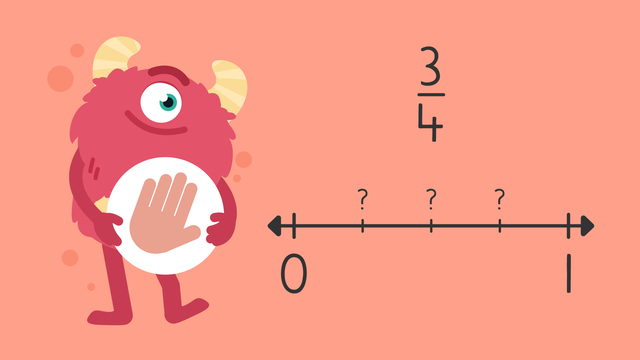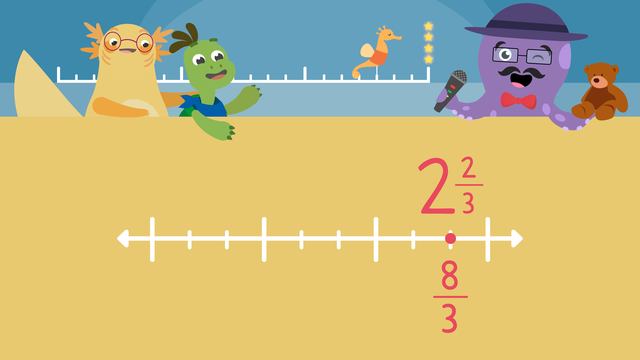Fractions on a Number Line
Basics on the topic Fractions on a Number Line
Fractions on a Number Line
Imagine you are on a treasure hunt, but to open the secret door to the hidden treasure you must complete two fraction number line puzzles. In order to complete the puzzles, you must first learn about plotting benchmark fractions on a number line 0 to 1. Not to worry – the following text will teach you how to become the treasure master!
How to Put Fractions on a Number Line
To show fractions on a number line, you can follow some simple steps. Fraction bars can help when showing unit fractions on a number line. The infographic below shows the different steps to represent fractions on a number line:
Steps to represent fractions on a number line:
| Step # | What to do |
|---|---|
| 1 | Identify the denominator |
| 2 | Divide the number line into equal parts |
| 3 | Count forward from zero the numerator |
| 4 | Plot the fraction on the number line |
Plotting Fractions on a Number Line – Examples
Below are two examples of labelling fractions on a number line. The steps above can be followed to help plot fractions on a number line.
Fractions on a Number Line – First Example
The fraction is one-half. We see the denominator, the bottom number, is two. Using a fraction bar to help us, we can divide the number line into two equal parts.
Now we look at the numerator, the top number. This is a one, so we can count forward one part from the zero.
We have located where one-half is on the number line, so we can plot it at the correct location.
Fractions on a Number Line – Second Example
The fraction is two-thirds. We see the denominator, the bottom number, is three. Using a fraction bar to help us, we can divide the number line into three equal parts.
Now we look at the numerator, the top number. This is a two, so we can count forward two parts from the zero.
We have located where two-thirds is on the number line, so we can plot it at the correct location.
Fractions on a Number Line – Summary
It is treasure time! Do you understand fractions on a number line now? If you would like to practice some more, there are fractions on a number line practice problems and fractions on a number line worksheets after the video.
Transcript Fractions on a Number Line
Axel and Tank find a treasure map that shows there's a secret door nearby. Let's join them to find out more! "Oh, look Tank!" "I think we found it!" "Hmm. But how does the door open?" "It looks like we need to solve two puzzles by moving the sliders to represent Fractions on a Number Line" Remember, a fraction represents a part of a whole. A fraction bar like this can help when writing fractions on a number line. A fraction bar represents the whole, and each section is a part of the whole. We can set up a number line from zero to one where the one represents our whole! Now we are ready to represent one-third on a number line. First, identify the denominator. Next, divide the number line into equal parts matching the denominator. Then count the number of parts from zero shown in the numerator. Finally, write the fraction on the number line. Now we know how to write fractions on a number line, let's try an example together before we help Axel and Tank! Here we have the fraction one half. First we draw our number line. Now we look at the denominator and see we have two parts. We can use a half fraction bar to help us divide the number line into two equal parts right here. Now we look at the numerator and see we have one part. We count one part from zero, and write one half here. Okay, let's help Axel and Tank crack the code! What is your first step? Draw your number line then identify the denominator. Can you identify the denominator? Four is the denominator. Do you remember what the next step is? Use a quarters, or four parts, fraction bar to help you divide the number line into equal parts. What is your final step? You count from zero the number of parts you have as shown by the numerator. What is the numerator? The numerator is one so you count one part from zero. Finally, you write the fraction on the number line like this. Last, we need to show the fraction two-thirds on a number line. What is your first step? Draw your number line then identify the denominator. Can you identify the denominator? The denominator is three. What is your next step? Divide the number line into equal parts, using a thirds fraction bar to help. Can you remember the final step? You count from zero the number of parts you have as shown by the numerator. What is the numerator? The numerator is two so you count two parts from zero. Finally, you write the fraction on the number line like this. Remember to write fractions on a number line first, identify the denominator. Next, divide the number line into equal parts matching the denominator. Then count the number of parts from zero shown in the numerator. Finally, write the fraction on the number line. Yay, we helped Axel and Tank solve the puzzles! "I wonder where this will take us." "Let's go this way!" "Wait, that was it?" "But Axel, the treasure is our home!"
Fractions on a Number Line exercise
-
Describe how to place a fraction on a number line.
HintsTo know how many equal parts to divide the number line into, what do we need to identify first?
After we divide the number line into equal parts, we can count the number of parts from zero.
Solution- Identify the denominator.
- Divide the number line into equal parts.
- Count the number of parts from zero.
- Write the fraction on the number line.
-
Which number line shows $\frac{1}{3}$ placed correctly?
HintsIdentify the denominator (bottom number) and divide the number line into equal parts matching the denominator.
Count the number of parts from 0 shown in the numerator (top number) and place the fraction on the number line.
SolutionStep 1: Identify the denominator, 3.
Step 2: Divide the number line into 3 equal parts.
Step 3: Count 1 part (the numerator) from 0.
Step 4: Place $\frac{1}{3}$ on the number line. -
Match the fraction to the number line.
HintsIdentify the denominator (bottom number) and divide the number line into equal parts matching the denominator.
Count the number of parts from 0 shown in the numerator (top number) and place the fraction on the number line.
Solution$\mathbf{\frac{3}{4}}$
Step 1: Identify the denominator, 4.
Step 2: Divide the number line into 4 equal parts.
Step 3: Count 3 parts (the numerator) from 0.
Step 4: Place $\frac{3}{4}$ on the number line. ___________________________________________________________________________________________________ For the other fractions:
$\mathbf{\frac{1}{2}}$
Step 1: Identify the denominator, 2.
Step 2: Divide the number line into 2 equal parts.
Step 3: Count 1 part (the numerator) from 0.
Step 4: Place $\frac{1}{2}$ on the number line.$\mathbf{\frac{3}{3}}$
Step 1: Identify the denominator, 3.
Step 2: Divide the number line into 3 equal parts.
Step 3: Count 3 parts (the numerator) from 0.
Step 4: Place $\frac{3}{3}$ on the number line.$\mathbf{\frac{1}{4}}$
Step 1: Identify the denominator, 4.
Step 2: Divide the number line into 4 equal parts.
Step 3: Count 1 part (the numerator) from 0.
Step 4: Place $\frac{1}{4}$ on the number line. -
Match the number line with the fraction.
HintsIdentify the denominator and divide the number line into equal parts matching the denominator.
Count the number of parts from 0 shown in the numerator and place the fraction on the number line.
Remember the denominator is the bottom number and the numerator is the top number.
Solution$\mathbf{\frac{2}{5}}$
Step 1: Identify the denominator, 5.
Step 2: Divide the number line into 5 equal parts.
Step 3: Count 2 parts (the numerator) from 0.
Step 4: Place $\frac{2}{5}$ on the number line. ___________________________________________________________________________________________________ For the other fractions:
$\mathbf{\frac{1}{4}}$
Step 1: Identify the denominator, 4.
Step 2: Divide the number line into 4 equal parts.
Step 3: Count 1 part (the numerator) from 0.
Step 4: Place $\frac{1}{4}$ on the number line.$\mathbf{\frac{2}{3}}$
Step 1: Identify the denominator, 3.
Step 2: Divide the number line into 3 equal parts.
Step 3: Count 2 parts (the numerator) from 0.
Step 4: Place $\frac{2}{3}$ on the number line.$\mathbf{\frac{2}{4}}$
Step 1: Identify the denominator, 4.
Step 2: Divide the number line into 4 equal parts.
Step 3: Count 2 parts (the numerator) from 0.
Step 4: Place $\frac{2}{4}$ on the number line. -
Which number line shows $\frac{1}{2}$ placed correctly?
HintsIdentify the denominator (bottom number) and divide the number line into equal parts matching the denominator.
Count the number of parts from 0 shown in the numerator (top number) and place the fraction on the number line.
SolutionStep 1: Identify the denominator, 2.
Step 2: Divide the number line into 2 equal parts.
Step 3: Count 1 part (the numerator) from 0.
Step 4: Place $\frac{1}{2}$ on the number line. -
Place the fractions on the number line.
HintsIdentify the denominator and divide the number line into equal parts matching the denominator. Then, count the number of parts from 0 shown in the numerator and place the fraction on the number line.
Look at the fractions with the same denominator, but with different numerators, and place them on the number line.
Look at the fractions with the same numerator, but with different denominators. Which piece would be bigger, a piece divided into 4 parts or 3 parts? Whichever one you think is bigger will be closer to 1.
Solution$\frac{1}{2}$
Step 1: Identify the denominator, 2.
Step 2: Divide the number line into 2 equal parts.
Step 3: Count 1 part (the numerator) from 0.
Step 4: Place $\frac{1}{2}$ on the number line.$\frac{1}{3}$
Step 1: Identify the denominator, 3.
Step 2: Divide the number line into 3 equal parts.
Step 3: Count 1 part (the numerator) from 0.
Step 4: Place $\frac{1}{3}$ on the number line.$\frac{3}{3}$
Step 1: Identify the denominator, 3.
Step 2: Divide the number line into 3 equal parts.
Step 3: Count 3 parts (the numerator) from 0.
Step 4: Place $\frac{3}{3}$ on the number line.$\frac{1}{4}$
Step 1: Identify the denominator, 4.
Step 2: Divide the number line into 4 equal parts.
Step 3: Count 1 part (the numerator) from 0.
Step 4: Place $\frac{1}{4}$ on the number line.$\frac{3}{4}$
Step 1: Identify the denominator, 4.
Step 2: Divide the number line into 4 equal parts.
Step 3: Count 3 parts (the numerator) from 0.
Step 4: Place $\frac{3}{4}$ on the number line.





















